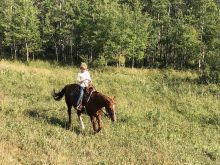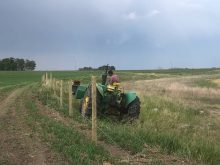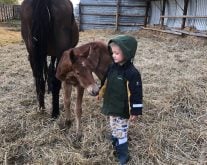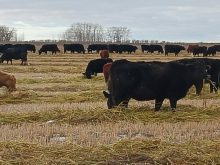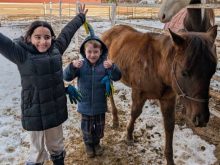Editor’s Note: Keep in mind seasons in Australia are reversed: spring — September to November; summer — December to February; autumn — March to May, and winter — June to August.
Most graziers, at least in Western Canada, equate swath grazing to images of cows with snow on their back line and with frozen muzzle whiskers sweeping their heads back and forth like a buffalo while discovering good-quality feed below thick layers of snow.
That’s exactly what I enjoyed watching for many winters up on 4-Clover Ranch near Rocky Mountain House, Alta. — content cows feeding themselves on restricted areas of windrowed barley and oat combinations. Enjoyment came also from the improved economics of this feeding practice versus tractor feeding. The savings in manpower, and then the observations the following spring with tremendous fertility enhancements across the swath-grazed field from evenly distributed manure benefitting the subsequent crop. It was my kind of winter feeding.
Read Also

Harvest wraps up and fall work begins
At the Eppich famly ranch in western Saskatchewan, the fall harvest was successful with few breakdowns, cows and calves have been sorted and a new tractor has arrived
Writing this article on a warm Australian summer day, I must admit I sort of miss those nice days of clear, blue winter skies. Then memories of cows on the wrong side of the electric fence or days with strong winds, ice fog and minus 40 C, and things are tipping to the not-so-fond side of the practice. Overall though, swath grazing was a great adoption that we fully embraced for many years.
Meanwhile here in Australia on our Alcheringa Pastoral property, I’m thinking about how to reduce the effects of a hot, dry summer on our feeder cattle’s performance. I wonder that it may not be that different conceptually to apply Canada’s winter swath grazing here albeit for a completely different season.
Summer arrives quickly
The summer in Australia often arrives with a swiftness that catches you off guard. Winters in southwest Victoria are cool and rainy, often too cold to provide much growth. Ground is soft, and we prefer not to have cattle grazing during this time of the year. Conveniently, this lines up well with our desire to be tending to our Alberta ranch and enjoying the Alberta summer. When we return to our Southern Hemisphere grazing, it is late spring and the warming and often hot days quickly bring growth on in ways not unlike an Alberta spring. The key difference is that the temperatures increase, and precipitation declines very rapidly.
Due to hot, dry conditions in most southwest pastures, plant growth eventually stops around the new year. The reaction for most pasture species following rapid spring growth is quickly to set seed followed by a sharp decline in feed value and palatability. It becomes very difficult to get desired pasture utilization and herd impact even under high stock densities without compromising livestock performance.
Phalaris is one forage species we have that is especially challenging with this phenomenon of a rapid transition from low-fibre nutritious feed to unpalatable stalky material. Phalaris is closely related to reed canary grass. So, while challenging to manage, it does provide tremendous yield, has great longevity and tolerates wet feet and is thus a popular pasture grass in our part of Victoria.
Last year we did some experimental cutting when the phalaris was at its optimum feed value stage, just headed and still quite leafy. The windrows were left on the ground and with remaining soil moisture, we did see some regrowth between swaths. Two months later, the brown dried feed along with the green regrowth was surprisingly palatable and stock very contently grazed the test-swathed area.
This year we did it on a larger scale. The heifers have just begun grazing the swathed phalaris paddock and indications from dung score, gut fill and stock conditions look promising.
This Aussie-style swath grazing may have merit and become a preferred summer feeding strategy for us, although much more unorthodox here than in Canada. While we will never achieve the grazing days per acre that we had up on 4-Clover Ranch, it is another step toward finding an easier way to take cattle through the hot summer. Ah’ fun and games on Alcheringa Pastoral.



